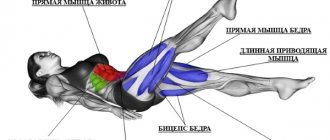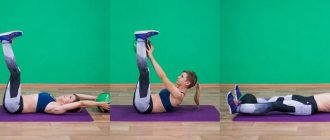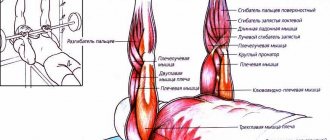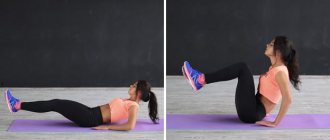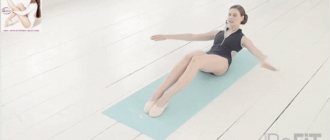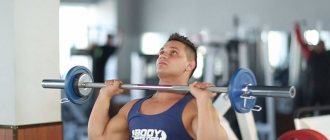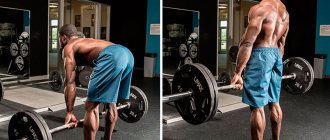≡ December 21, 2020 Category: Exercises by muscle group
For some advanced athletes who go to the gym, the training program involves performing specific exercises. Some of these movements acquire second names after long practice. These include the exercise known among experienced athletes as “Good morning”. Unlike the second name, this exercise is not very popular among those who want to quickly gain weight and pump up, but its benefits for the body are considerable. Therefore, in today’s article we will pay attention to precisely this type of action, which in the world of sports is called – bending forward with a barbell on the shoulders.
The main factor that played a role in the formation of the second name - Good morning, was the principle of reproducing movements during bending forward with a barbell. Similar to bowing when greeting, they are very valuable in training the lower back, buttocks, hamstrings, and indirectly the abs.
What muscles work in the Good morning exercise?
The exercise is similar in effect to a hyperextension or straight-legged deadlift, but it also works the back of the body.
The main impact falls on the back extensors. The gluteus maximus and hamstrings are also involved in this exercise, but to a lesser extent. The abs are indirectly trained.
Muscles working during the Good Morning exercise
Performing the exercise only using the buttocks and thigh muscles is a mistake.
However, some people persistently promote barbell bending as an exercise for working the buttocks and legs. For this purpose, it is better to perform Romanian deadlifts. The exercise is similar, but aimed primarily at the legs.
Forward bends with a barbell, or the “GOOD MORNING” exercise
≡ December 21, 2020 Category: Exercises by muscle group
For some advanced athletes who go to the gym, the training program involves performing specific exercises. Some of these movements acquire second names after long practice.
These include the exercise known among experienced athletes as “Good morning”. Unlike the second name, this exercise is not very popular among those who want to quickly gain weight and pump up, but its benefits for the body are considerable.
Therefore, in today’s article we will pay attention to precisely this type of action, which in the world of sports is called – bending forward with a barbell on the shoulders.
The main factor that played a role in the formation of the second name - Good morning, was the principle of reproducing movements during bending forward with a barbell. Similar to bowing when greeting, they are very valuable in training the lower back, buttocks, hamstrings, and indirectly the abs.
An ordinary exercise with an unusual name, Good Morning, uses a decent group of muscles. Basically, it is designed to work the muscle tissue of the posterior chain.
In addition, the atlas of muscles involved in the exercise includes the following.
Basic:
- lower and middle back, as well as spinal extensors;
- hamstring muscles (biceps, semimembranosus, semitendinosus);
- large gluteals.
Additional muscles are the external oblique and rectus abdominis muscles.
The full picture of the muscle atlas is presented in the photo, and the execution technique is shown in the video.
Despite its simple name, good morning, this exercise is unique from the point of view of performing movements. To achieve greater efficiency, it is necessary to correctly perform all stages of physical actions, starting with taking the starting position and observing proper breathing, which ensures increased efficiency of the “good morning” exercise.
Before you begin physically greeting and performing good morning, you need to take the starting position: standing, feet shoulder-width apart.
From this position, bend forward to grab the barbell with a wide grip with your palms facing you, and place it, straightened, on your trapezium. In this case, the body should be straight, the chest should be directed forward, and the shoulders should be straightened.
Keep your lumbar muscles tight to get the desired effect from your good morning sports greetings.
Helpful advice
The movements should begin with slightly bent knees. Smoothly bending forward with a barbell on your shoulders, you need to simultaneously move your pelvis back, continuing the action until the moment when the body becomes parallel to the floor. After bending, also smoothly return to the starting position.
It is important to pay attention when performing the exercise with the interesting name Good Morning, the basis of the movements is a change in the position of the hip joint. That is, the forward tilt of the body occurs due to flexion of the pelvis (which can be seen in the video below), and not according to the principle of classical bending, in which flexion is carried out in the lumbar region.
Breathing technique is also important when performing good morning bends. Having taken the starting position with the barbell on your shoulders, inhale while bending. You can exhale when returning to the starting position.
The execution technique will be ideal as all the nuances of the Good Morning exercise are mastered. In addition, having mastered some experience in the classic implementation of the Good Morning exercise, you can try its other variations:
- bending forward with a barbell on your shoulders from a sitting position on a bench;
- bending forward while standing with one leg extended in front of oneself;
- standing forward bends when using a Smith machine;
- Good morning at home with body bending over the table.
In order for the exercise with the simple name Good Morning (or Good Morning) to stimulate the work of the above muscle groups (hips, buttocks, back and abs), you should follow the recommendations:
- when performing movements, the gaze should always be directed forward, as can be seen in the video;
- since the effectiveness of Good morning does not lie in gaining weight, but in strengthening the back and increasing muscle strength, it is not recommended to use heavy weights;
- It is recommended to do Good Morning in combination with deadlifts, 2-3 sets each of 8-10 repetitions.
Forward bends with a barbell, or the “GOOD MORNING” exercise, is a technique aimed at strengthening the muscular corset of the back (in particular the muscles of the lower part). The exercise also allows you to train your buttocks, giving them a rounded and sculpted shape. In addition, the back of the thigh is well worked out and stretched.
It is recommended to perform forward bends with a barbell along with deadlifts, presses and lunges.
Read more: Arm training for mass and relief for men: 8 week specialization program for arms in the gym
Muscles at work
When performing the “GOOD MORNING” exercise, the following muscle groups are involved in the work:
- The main ones are the muscles of the lower back and spinal extensors, buttocks, and the back of the thigh.
- Additional group - the middle part of the back, rectus abdominis and oblique muscles.
The main equipment is a bar.
For beginners, it is recommended to use a bodybar first, gradually adding weights to it. And only after that can you use a heavy projectile.
Execution technique
At first glance, you may think that the GOOD MORNING exercise has a simple technique. This is not entirely true. Even a slight deviation from the correct technique can lead to pain and injury to the lower back.
Starting position:
- Place your feet shoulder-width apart, bend your knees slightly and arch your back;
- Take the barbell with a wide grip and fix it on the back of the shoulder girdle;
- Make sure your back is stiff and your shoulder blades are joined together;
- Bend smoothly forward while moving your pelvis back;
- When fixing your torso parallel to the floor, return to the starting position.
As you inhale, lower your body down, and as you exhale, return to the starting position.
Be careful! You lean forward with the barbell by working the hip joint and in no case the lower back.
There are several variations of the “GOOD MORNING” exercise:
- while sitting on a sports bench;
- with emphasis on the leg put out in front of you;
- performing the technique on one leg.
Possible mistakes
The main mistakes when performing the technique are:
- bending due to extension of the lower back. That's right - by using the force of the hip joints (buttocks and biceps);
- complete relaxation of the spinal extensor muscles. That's right - this muscle group should not be completely relaxed, otherwise the tension moves to the lower back;
Recommendations
- When bending forward with a barbell, do not lower your head down, but look in front of you all the time;
- do not use too much weight on the projectile, since the main emphasis is on the back muscles;
- When performing the technique, make sure that your knees are slightly bent, this increases stability and protects against injury.
It is impossible to safely lift heavy weights without strong posterior chain muscles.
Considering the load that falls on the back, gluteal muscles and biceps of the thighs when practicing CrossFit, you need to use all possible methods of strengthening these muscles - deadlifts, Romanian deadlifts, rows, hyperextensions, etc. But this time we will shed light on forward bends with a barbell, called “good morning” in the West (translated as “good morning”).
Bent-overs with a barbell, as mentioned above, load the muscles of the posterior chain, namely:
- erector spinae muscle
- hamstrings
- gluteal muscles
- upper back muscles
- blade stabilizer
- rectus and oblique abdominal muscles
Execution technique
- Stand up to your full height, take the barbell and place it on your back - as when doing squats (the bar is located on the rear deltoids);
- Turn your toes slightly away from each other and bend your knees slightly (the angle at the knees should remain the same throughout the entire execution);
- Move your pelvis as far back as possible and tilt your body forward until it is parallel to the floor. Remember to keep your spine in a neutral position. The main limiting factor when performing a bend may be the flexibility of the hamstrings;
- As soon as your body reaches parallel to the floor, begin to return it to a vertical position, while simultaneously pulling your pelvis forward.
Barbell curls can be performed while seated to isolate the back muscles and reduce stress on the hamstrings. Other options for “good mornings” include bending over with a dumbbell, on one leg, with a rubber loop, or Zercher’s “good mornings.”
Benefits of Execution
Strengthening the lower back. Barbell squats, deadlifts, and weightlifting movements require strong lower back muscles. Increasing isometric stress on the erector spinae and engaging the glutes and hamstrings can help avoid injury and improve performance.
Development of the buttocks and hamstring muscles. For this reason, “good mornings” can often be found in training programs for powerlifters and weightlifters. The goal of performing barbell bends is not only muscle hypertrophy, but also to develop the correct motor patterns, which can later be transferred to competitive movements.
Upper back strength. The ability of muscles to prevent spinal flexion is what reduces the risk of injury when performing deadlifts and squats.
Integrating barbell curls into your training plan depends on your workout goals. As a general rule, perform 3-4 sets of 8-12 repetitions to hypertrophy and develop strength in the lower back and hips. It is not recommended to use a heavy weight apparatus in this exercise.
Bent-overs can also be used as a warm-up with several sets of 8-10 barbell reps at 30X0 tempo.
20 June 2009
Good morning is not only a good morning wish in the language of the Celts and their descendants, but also an affectionate name for an excellent exercise that builds strength, shapes and increases the attractiveness of the muscles of the lower back, buttocks and hamstrings.
If you include this movement in your training program, then quite quickly you can feel how your buttocks are filled with berries, your legs are tightened at the back, and an attractive “butterfly” appears in the lumbar region.
Technique for performing “Good morning” bends with a barbell while standing (on straight legs)
A standing exercise requires a lot of concentration and attention from the athlete, especially if performed with heavy weight, so a sitting option is more suitable for a beginner.
But if you want to actively engage the back of your legs and buttocks, then it is better to perform the bends while standing, but with light weight.
You can perform this exercise with both straight legs and slightly bent knees.
Technique (not only for girls):
- Remove the bar from the racks. When removing the barbell, you should not stand on your toes, so adjust the stands to your height in advance.
- Typically, when we squat or perform other exercises with a barbell on our shoulders, it rests on the shoulder girdle and upper trapezius. In this case, it needs to be placed a little lower. If you place the barbell, as usual, at the very top of the trapezoid, then when tilted it will roll down a little and put pressure on your neck.
On the left the position of the bar is convenient for squats and lunges, on the right - for bending
- Remove the bar from the racks and take 1-2 steps back.
- We place our feet approximately shoulder width apart.
- The back should be straight and rigid during all stages of the exercise. It is not allowed to bend over with a relaxed slouched back.
- We bend our knees a little to take a more stable position, and also to allow the body to bend lower with a straight back.
- Inhale and lean forward, moving your pelvis back.
- We bend down to the level that you can still do it with a straight back. You need to bend down until it is parallel to the floor, but if you can’t do this, you don’t need to try to “pull out” the exercise by rounding your back.
- Exhale and return to the starting position.
Also, watch the training video.
Video: How to do the exercise correctly - technique for performing standing bends
Correct technique: how to do it correctly
Good morning is not recommended for beginners , as it requires developed core muscles to keep the back straight. In addition, bending over with a barbell requires careful adherence to technique. It is well suited for athletes with average and high levels of training.
So, let’s move on to the good morning exercise technique:
- Take a barbell and place it on your back, in the position you would normally perform a squat. This means that the bar should rest on the traps, below the neck, or on the rear delts (just above the shoulder blades). Stand straight, bend your legs slightly at the knees , place them slightly wider than your shoulders, and turn your toes slightly to the sides. Tighten your upper back, squeeze your shoulder blades, and create a natural arch in your lower back. The back and lower back should be toned throughout the entire approach. In particular, you should not “loose” your back at the lowest point of the amplitude when the body is tilted forward.
- Keeping your back straight, lean forward with the barbell (as if down). As you move, push your buttocks back and maintain an arch in your back. Important point: The depth of the bend when performing the exercise while standing depends on the flexibility of the hamstrings. Ideally, of course, you need to bend over until your body is parallel to the floor.
However, don't risk trying to go deeper than your stretch allows. Lift yourself up through contraction of your glutes, hamstrings, and lower back. Also, when lifting the body, it is important to lift the upper body, and move the buttocks and pelvis back.
Upper block row: technique, variations. How to learn to do pull-ups?
Nuances from the photo
- Notice the slight "bend" in the legs . Only trained athletes with good leg stretching and great mobility in the hip joints can perform forward bends with a barbell while standing on straight legs. However, despite the fact that the legs should always be bent, there is no need to turn this exercise into something like a squat.
- It is very important to choose the right weight. It should be comfortable enough for you to do 6-8 high-quality repetitions with the highest possible amplitude for you. As a rule, the weight chosen is no more than 20-30% of the weight used in barbell squats. However, here it is better to take less, but do it right.
- If you have back problems, it is better to refrain from bending over with a barbell on your shoulders . Any chronic pain in the lumbar region will only get worse under stress.
- The exercise should be performed thoughtfully, at a uniform, not fast pace, and without jerking or other psychoses, because any sudden movement can damage the spine .
- If this exercise seems too difficult for you, try preparing for it using these simple complexes:
- Don't nod off, your gaze is always directed forward . Having lifted too much weight, many people look at the floor because they are afraid to raise their head up. This is another popular mistake that should never be made, as it can lead to crooked posture. Looking up is very important as it helps keep the weight on your shoulders correctly. Don't brag, take lighter weight.
- Don't neglect warming up before doing bends. It allows the muscles to prepare for work. It is enough to make several circular movements of the pelvis and tilts so that the body comes into a state of readiness.
- Under no circumstances should you round your shoulders. Again, this indicates that the weight is too much for you, even if you bend under its weight. This is ineffective and very dangerous for the back muscles and spine.
- Include the exercise on your back workout day at the beginning or end of your workout, or even better: before or after the deadlift .
Dumbbell flyes: lying and standing
Technique for performing Good morning bends while sitting
When you want to isolate your back without engaging your hamstrings and glutes, you can do this exercise while sitting. This option will also be good for beginners.
But keep in mind that since the leg muscles are not involved in the exercise, there is more strain on the back, so you need to be careful with the weight and technique.
If you want to include more spinal extensors in your work, do the exercise while sitting
Technique:
- We remove the barbell from the racks, place it on the trapezius muscles and shoulders, holding it in our hands.
- We sit on a bench with a straight back.
- We place our feet firmly on our entire feet, with our toes slightly turned to the sides.
- Inhale and bend down as far as possible.
- As you exhale, return to the starting position.
Video: Bent-overs with a barbell while sitting
How to do "Good morning"?
The exercise seems quite simple to perform, but nevertheless it is important to remember a few simple rules:
- First of all, you need to learn
- Place the barbell on the back of the deltoid muscles to ensure a secure exercise. A high position of the barbell is also acceptable; in this case, the load on the hamstrings and lower back increases.
- Don't bend over until you're parallel to the floor or, worse, lower. It is enough to stop about 15 degrees above parallel.
- To start, use a weight that is 25% of what you do squats with, then gradually increase the load.
- Do not perform the exercise with straight legs. This will cause the barbell to move forward too much, which will create excessive pressure on the lower back.
The “Good Morning” exercise with a barbell is very similar in technique to squats:
- The beginning is similar to squats. Stand straight with your feet shoulder-width apart. Place the barbell on your shoulders, take a deep breath and tighten your abdominal muscles.
- Begin to push your hips back, slightly bending your knees. Continue to push your hips back, lowering your torso until it is almost parallel to the floor. At the bottom, your shins should remain perpendicular to the floor and your knees should be slightly bent.
- Slowly bring your hips forward and So you said “Good morning” to the gym.
The exercise is quite simple to perform, but it is better at first, if you are practicing on your own, to film the technique on video so that you can analyze the errors.
Recommendations for the exercise
Remember that Good morning requires certain physical preparation and attention to execution technique. For the safety and effectiveness of the training, do not forget about the following points:
- Bends should be performed while sitting or standing 8–10 times, 3–4 working approaches.
- Good Mornings can be performed in conjunction with deadlifts to work the entire back of the body as effectively as possible.
- Bends with minimal weight can be used as rehabilitation during the recovery period after injuries, but only with the permission of a doctor.
- If you have a weak back, you should not start with this exercise, as it requires attention and an understanding of the mechanics of all muscles. You can practice by doing deadlifts or hyperextensions.
- Do not lower your head too much, your gaze should be directed straight.
If you want to increase your performance in basic exercises such as deadlifts or squats, then be sure to include Good morning in your training. If an athlete has a weak back, then using large weights will not be possible with the correct technique. During squats, the legs begin to “turn” inward, and lower back pain may appear. To avoid this, develop your back, and the Good Morning exercise will help you with this.
Is the exercise dangerous?
As with any other physical activity, despite all the benefits and active work of various muscle groups, there are always risks.
“Good morning” is an exercise that is great for working the hamstrings and back, but if done incorrectly, it is also the most dangerous of all.
The risk of injury is greatest when the body is closest to parallel to the floor. In this case, the weight of the bar puts maximum pressure on the spine. If the technique is incorrect and the back muscles are not strong enough, this is a direct path to sick leave.
If you are a beginner, then do not rush to do the good morning exercise, first practice squats and
You should also remember that this is one hundred percent not an exercise where you should experiment with extremely heavy weights. In this case, it's all about technique, and if you want to show off your strength, there are plenty of other back-friendly options.
Exercise “Good morning” - a simple but effective exercise for the hips and buttocks
The problem of loose skin on the buttocks, thighs and abdomen worries most women, and this applies not only to those who suddenly lose weight and gain weight.
It's no secret that the buttocks are one of the main problem areas of the female figure. It so happens that it is in these places (buttocks, thighs, stomach) that our body stores fat reserves in order to use them in case of unforeseen circumstances.
Human skin becomes less elastic with age, and often does not always keep up with changes in weight. In this regard, it turns out that even at a fairly young age, after significant weight loss, unsightly folds appear. In addition, after 40 years, our skin begins to adhere loosely to the muscles (this is observed not only in problem areas of the body, but even on the face). Under the influence of many factors, the skin begins to sag, and if absolutely no measures are taken, noticeable sagging occurs not only in the abdomen, hips, buttocks, but throughout the entire human body. Yes, indeed, after 40 years it is very difficult for our skin to continue to remain hydrated, fresh, and also tightened.
Most women try to take care of the skin on their face, but what about problem areas of the body? It's no secret that in this case physical exercise takes first place. Movement is beauty and also health! Physical training tones human muscles and promotes a significant flow of blood to the skin. Systematic physical activity affects the blood vessels (small ones), due to which the skin begins to persistently “feed” on blood, and as a result it looks toned and elastic.
It should be noted that it is best to visit gyms by immediately paying for monthly classes. In a situation where you do not have the financial ability to go to the gym, and you have no problems with self-organization, it is recommended to go through all the popular physical exercises and give preference to the ones that are most suitable for you personally.
There are many different complexes aimed at strengthening the muscles of the buttocks and thighs. However, you should not immediately rush into battle and “try on” all the available options. It is enough to start with simple and accessible exercises to see the first results of your labors within a week.
Today we will look at one of the most favorite exercises of the Russian fitness bikini champion Katya Usmanova for the buttocks - “Good morning”. Good morning forward bends are an excellent assistance exercise for working the back of the thighs, buttocks, and lower back. Regularly performing this exercise will help you visually separate your hamstrings from your buttocks and strengthen your lower back, which can protect you from back and spinal injuries in the future.

